
At Spangler, a candy-cane crunch
11/1/2006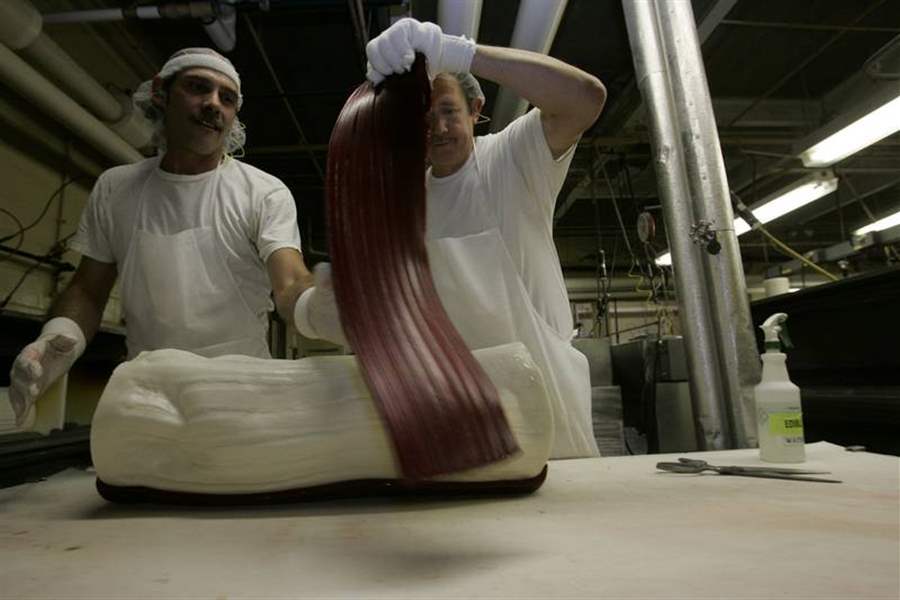
Bob Cooper, left, and Charles Smith add the stripe of color to a 20-pound log of candy.
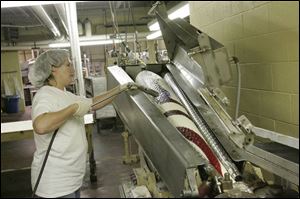
Using a special torch, Jill Nichols heats two sections to fuse them together as the candy's colors are twirled.
BRYAN - If demand for candy canes goes any higher, the Spangler Candy Co. may want to ask Santa Claus for some tips on meeting tight production schedules.
With Christmas less than two months away, Spangler's manufacturing plants in Bryan and Juarez, Mexico, are at record production levels - cranking out 3 million flavored canes daily.
The Williams County company, which also makes Dum Dums, Saf-T-Pops, and marshmallowy Circus Peanut candies, has been in a rush since June to increase candy cane production.
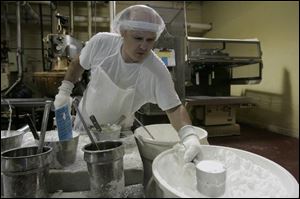
Near the beginning of the process, Jeff Roddy mixes flavoring ingredients.
Output at the northwest Ohio factory, which had operated two eight-hour shifts five days a week through May, moved to three shifts a day in June. In September, the three-shift schedule was extended to Saturdays, the first time in its history that its work went six days around the clock.
On an average day this fall, eight to 16 semitractor trailer trucks arrive at the plant to haul away the canes.
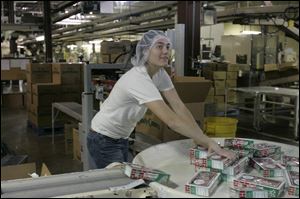
Melody Guilford arranges 40-cane boxes for packaging into cases.
At Juarez, three production shifts have been running all year five days a week. In September, Saturdays were added.
When production begins to decrease in early December, Spangler's candy cane sales will be only about 10 percent above last year's. But monthly factory activity since September has been about 30 percent over past years, Mr. Spangler said.
The reason for the surge is a combination of luck and unexpected demand, the CEO said.
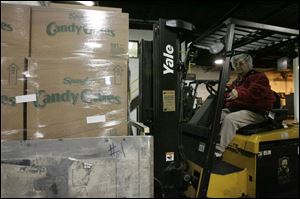
Bonnie Dangler loads cases onto trucks.
"One retailer, they'll be using over 1,200 truckloads just to service that retailer alone," said Dean Spangler, company president and chief executive officer. "We're very busy, but it's a great problem to have."
Last year, the company heard rumblings that some top customers planned to buy candy canes from lower-cost manufacturers in China.
Concerned it would get stuck with unwanted inventory, the company slowed first-quarter production.

Bob Cooper, left, and Charles Smith add the stripe of color to a 20-pound log of candy.
But Mr. Spangler said that, surprisingly, the Chinese threat never emerged.
By June, customers were placing even bigger orders than before, and two retailers of specialty candy canes also chose to increase orders.
"We had to scramble to fulfill the customer demands," the company leader said.
Even when production is reduced in December, employment in Bryan will stay higher than a year ago, he said.
It's now about 415 hourly workers.

Ranks of wrapped canes move toward packaging.
Teresa Tarantino, editor-in-chief at Professional Candy Buyer magazine, said Spangler was correct to take the Chinese threat seriously, even though it didn't materialize.
"China is a major supplier of candy," she said. "There is a lot of product coming in from China, but there are still a lot of issues regarding their meeting quality standards."
After factoring in transportation costs from China, U.S. retailers may have concluded that the imports would not save them money, she said.